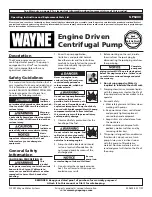
8
1. Shutoff valves and unions (or flanges) on suction and discharge piping. This permits check
valve inspection without draining long runs of piping. Shutoff valves should be of the same
size as connecting pipe. Ball valves are preferred since they offer minimum flow restriction.
2. An inlet strainer, if the product is not a slurry. Pump check valves are susceptible to dirt and
other solid contaminants unless designed for that service, and any accumulation can cause
a malfunction. The strainer should be located between the suction shutoff valve and the
pump suction valve. It must be sized to accommodate the flow rate and the anticipated level
of contamination. 100-mesh screen is recommended.
3. Vacuum/pressure gauges in the suction and discharge lines in order to check system
operation. Gauges should be fitted with protective shutoff valves for isolation while not in
use.
4. A back-pressure valve (BPV) on the discharge piping to create an established pressure
upon the pump valving to ensure proper seating of the check balls.
5. A separate system pressure relief valve (PRV) to protect piping and process equipment,
including the pump, from excess process pressures.
The hydraulic bypass valve (HBV) in the pump is not intended to protect the system!
Piping weight must not be supported by the valve housings or other portions of the reagent
head, as the resulting stresses can cause leaks. If appropriate, provide for thermal expansion
and contraction so that no excess force or moments are applied to the pump.
In piping assembly, use a sealing compound chemically compatible with the process material.
Users of sealing tape are cautioned to ensure that the pipe thread ends are not taped. Both
new and existing piping should be cleaned, preferably by flushing with a clean liquid (compatible
with process material) and blown out with air, prior to connection to the pump. Flow issues at
pump startup are often related to the check valves being fouled with piping and process debris.
4.3
SUCTION PRESSURE REQUIREMENTS
Although PULSAR metering pumps have suction lift capability, all pump installations should
have minimum lift for optimum performance. A flooded suction (i.e., suction pressure higher
than atmospheric pressure) is preferable whenever possible. The pump should be located as
close as possible to the suction side reservoir or other source. Piping should be sized to allow
for best possible NPSH conditions. (Preferably the same size as the pumps check valving size
at a minimum or larger)
It is not recommended to install a PULSAlarm equipped pump in a suction lift system.
If suction lift is required, the net positive suction pressure required (NPSHr) is 0.21 bar (or 3
psia). If this requirement is not met the process liquid may cavitate inside the pump, degrading
metering accuracy. To maintain prime on a suction installation, a foot valve is required. In
addition, suction pressure must be maintained at a minimum absolute value of 0.35 bar (or 5
psia) to ensure proper hydraulic system and proper pump operation.
The maximum inlet pressure is limited to 30 psig with the standard composite diaphragm.
Higher suction pressures may be accommodated with optional diaphragm configurations.
It is critical that PULSAR pumps have free flowing and unobstructed suction conditions
at all times. Closed valves, clogged strainers, obstructed piping, etc., are to be avoided.
Summary of Contents for PULSAR 25HJ
Page 53: ...47...














































